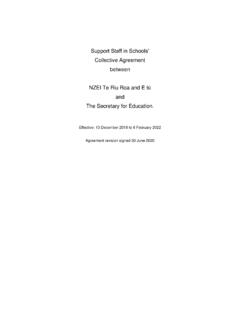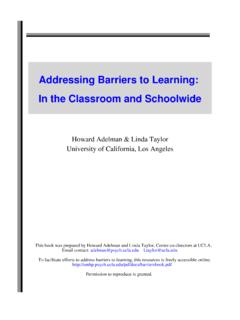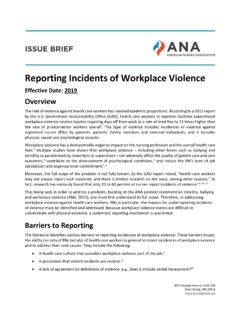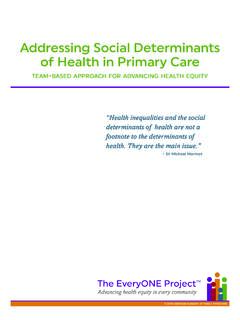Transcription of The Statement of National Education and Learning ...
1 The Statement of National Education and Learning Priorities (NELP) & Tertiary Education Strategy (TES)The Statement of National Education and Learning Priorities (NELP) and the Tertiary Education Strategy (TES) are issued under the Education and Training Act 2020. The NELP must be consistent with the objectives for Education . These are: helping children and young people to attain their educational potential; preparing young people for participation in civic and community life and for work, and promoting resilience, determination, confidence, creative and critical thinking, good social skills and the ability to form good relationships; and helping children and young people to appreciate diversity, inclusion and Te Tiriti o Waitangi.
2 The TES must set out the Government s long-term strategic direction for tertiary Education , including economic, social, and environmental goals, and the development aspirations of M ori and other population of the purposes of the Act is to establish and regulate an Education system that honours Te Tiriti o Waitangi and supports M ori-Crown relationships. Section 9 sets out the main provisions of the Act in relation to the Crown s responsibility to give effect to Te Tiriti o Waitangi. These provisions include obligations in relation to Te Tiriti o Waitangi for school boards, tertiary Education institutions and Education places of Learning are safe, inclusive and free from racism, discrimination and bullyingReduce barriers to Education for all, including for M ori and Pacific learners/ konga, disabled learners/ konga and those with Learning support needsMeaningfully incorporate te reo M ori and tikanga M ori into the everyday life of the place of learningCollaborate with industries and employers to ensure learners/ konga have the skills, knowledge and pathways to succeed in workEnhance the contribution of research and m tauranga M ori in addressing local and global challenges (TES ONLY)
3 Have high aspirations for every learner/ konga, and support these by partnering with their wh nau and communities to design and deliver Education that responds to their needs, and sustains their identities, languages and culturesEnsure every learner/ konga gains sound foundation skills, including language*, literacy and numeracyDevelop staff to strengthen teaching, leadership and learner support capability across the Education workforcePRIORITIESIn particular, licensed early Learning services are required to have regard to the NELP as part of the Governance, Management and Administration (GMA) Standard. Boards of schools and kura must have particular regard to the NELP, including when developing or renewing their TES sets the direction for tertiary Education .
4 Tertiary Education Organisations are required to show how they have regard for the TES. The Tertiary Education Commission must give effect to the TES, and the New Zealand Qualifications Authority must have regard for the NELP and TES are statutory documents enabled by the Education and Training Act 2020 that set out the Government s priorities for Education . This document forms both the NELP (priorities 1-7) and the TES (priorities 1-8). Some aspects of these priorities will be more applicable to one sector than NELP is designed to guide those who govern licensed early Learning services, ng k hanga reo, schools and kura. 24613578* Oral language encompasses any method of communication the learner/ konga uses as a first language.
5 Including New Zealand sign languageLEARNERS AT THE CENTREL earners with their wh nau are at the centre of educationBARRIER FREE ACCESSG reat Education opportunities and outcomes are within reach for every learnerQUALITY TEACHING AND LEADERSHIP Quality teaching and leadership make the difference for learners and their wh nauFUTURE OF Learning AND WORKL earning that is relevant to the lives of New Zealanders today and throughout their livesWORLD CLASS INCLUSIVE PUBLIC EDUCATIONNew Zealand Education is trusted and sustainableOBJECTIVE 1 OBJECTIVESOBJECTIVE 2 OBJECTIVE 3 OBJECTIVE 4 OBJECTIVE 5 Statement of National Education and Learning Priorities and Tertiary Education Strategy 1 Implementation of the Statement of National Education and Learning Priorities in licensed early Learning servicesThe Education (Early Childhood Services) Regulations 2008 require licensed early Learning service providers to have regard to the NELP as part of the Governance, Management and Administration (GMA) Standard.
6 Licensing criteria will be amended to align with and support the GMA Statement of National Education and Learning Priorities (the NELP) is a set of priorities designed to guide those who govern licensed early Learning services, including ng k hanga reo, to focus their day-to-day work on things that will have a significant positive impact for children and young people. The priorities can be used alongside the service s own local priorities, to help every learner/ konga to progress and achieve their aspirations. OBJECTIVE 1 OBJECTIVE 2 OBJECTIVE 3 OBJECTIVE 4 OBJECTIVE 5 LEARNERS AT THE CENTREL earners with their wh nau are at the centre of educationBARRIER FREE ACCESSG reat Education opportunities and outcomes are within reach for every learnerQUALITY TEACHING AND LEADERSHIPQ uality teaching and leadership make the difference for learners and their wh nauFUTURE OF Learning AND WORKL earning that is relevant to the lives of New Zealanders today and throughout their livesWORLD CLASS INCLUSIVE PUBLIC EDUCATIONNew Zealand Education is trusted and sustainable Actions for early Learning services1 Ensure places of Learning are safe, inclusive and free from racism.
7 Discrimination and bullying2 Have high aspirations for every learner/ konga, and support these by partnering with their wh nau and communities to design and deliver Education that responds to their needs, and sustains their identities, languages and cultures3 Reduce barriers to Education for all, including for M ori and Pacific learners/ konga, disabled learners/ konga and those with Learning support needs4 Ensure every learner/ konga gains sound foundation skills, including language, literacy and numeracy5 Meaningfully incorporate te reo M ori and tikanga M ori into the everyday life of the place of learning6 Develop staff to strengthen teaching, leadership and learner support capability across the Education workforce7 Collaborate with industries and employers to ensure learners/ konga have the skills, knowledge and pathways to succeed in work8 Enhance the contribution of research and m tauranga M ori in addressing local and global challenges (TES ONLY)
8 Ask learners/ konga, wh nau and staff about their experience of racism, discrimination and bullying, and use that information to reduce these behavioursHave processes in place to promptly address and resolve any complaints or concerns about racism, discrimination and bullyingCreate a safe and inclusive culture where diversity is valued and all learners/ konga and staff, including those who identify as LGBTQIA+, are disabled, have Learning support needs, are neurodiverse, or from diverse ethnic communities, feel they belongPartner with family and wh nau to equip every learner/ konga to build and realise their aspirationsHelp staff to build their awareness of bias and low expectations, and of how these impact learners/ konga, staff and wh nauIdentify and respond to learner/ konga strengths, progress and needs, and learner/ konga and wh nau aspirationsBuild relationships with M ori, involve them in decision making, and partner with them to support rangatiratanga, and M ori educational success as M oriMake use of targeted Ministry of Education funding to reduce parental fees and help address other financial barriers, such as food, clothing and transport, and support wh nau and Pacific families to apply for funding available to reduce the costs of early childhood educationEnsure disabled learners/ konga and staff, those with Learning support needs, and neurodiverse learners/ konga.
9 Are safe and included in their early Learning service, and their needs are supportedWork with wh nau and Pacific families to identify and understand barriers that may prevent learners/ konga from accessing and participating in early learningBuild on the language Learning , literacy, and numeracy practices learners/ konga experience in their own home or community, including dual or multi-lingual households, and value the cultural knowledge each child and their wh nau bring to literacy educationOffer multiple opportunities for interaction and conversation - regularly conversing with individual or small groups of learners/ konga using descriptive vocabulary, reading stories together, playing verbal games or singing waiata to support their language development.
10 And incorporate regular opportunities for learners/ konga to explore symbols from their own and other cultures, including mathematical symbolsProvide consistency of teachers/kaiako, educators and caregivers, so young learners/ konga can develop attachment and positive relationships to support Learning and wellbeingSeek advice from M ori on how best to include tikanga M ori in values, practices and organisational cultureProvide opportunities for teachers/kaiako and educators to build their teaching capability, knowledge and skills in te reo M ori and tikanga M ori, and support them to strengthen their teaching practices to integrate te reo M ori throughout implementation of the curriculumTalk with learners/ konga and staff about why correct pronunciation of te reo M ori is important, and provide them with opportunities to learn and practice without judgementIdentify gaps in teaching capability and invest in opportunities for teachers/kaiako, educators and staff to strengthen teaching, leadership and Learning supportDevelop teacher/kaiako confidence and competence to teach diverse learners/ konga with varying needs, and to appropriately modify teaching approachesExpect and support teachers/kaiako to build their understanding of learners / konga contexts.









